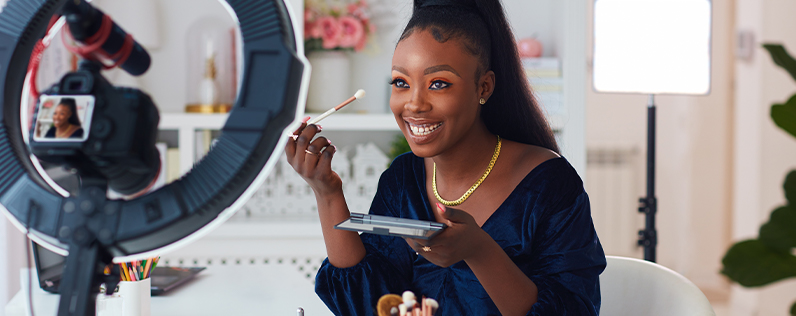
Consumers now spend more time engaged on social media than legacy media (like print, radio, and television). This is especially true for younger audiences, who also tend to harbor an anti-establishment distrust of large institutions and mass marketing efforts.
How can brands appeal to such a fragmented crowd? One of the answers is through influencer marketing. By leveraging social media content to spread organic endorsements from trusted figures, influencers turn its obstacles into attributes, and harness them to maximize brand messaging.
Let’s take a look at the nature of influencer marketing, assess whether it’s right for you, and discuss finding the right partner if the method seems a fit.
Intro to influencer marketing
“Influencer” is a term that generally describes anyone with a sizable social media following, and usually one gathered within a particular niche or interest.
“Influencer marketing” is simply the practice of partnering with such an influencer to deliver original brand messaging/awareness to their built-in, devoted audience.
Optimally, the approach is a hybrid between celebrity endorsement and word-of-mouth advertising: the spokesperson isn’t as famous as a movie star, but is still relatable and trusted. That means the material isn’t generic ad copy that’s ignored by an audience, but is rather content that they’ve subscribed to see.
And it works, as studies show that 92% of consumers trust such user-generated content more than traditional advertising.
Influencers can be found for most any conceivable audience and are available with a wide-range of followers, from nano-influencers (a few thousand) to mega versions (a few million), with pricing that varies accordingly. Similarly, they offer a spectrum of content spanning simple product placement to reviews to contests/viral challenges to full-on campaigns and brand ambassadorships.
Teaming with these entertaining, relatable voices who intimately know their audiences lends credibility to any message and can quickly increase/reshape brand awareness, while organically mastering platforms like Instagram, YouTube, and TikTok, brings your product to younger demos with disposable income.
Millennials, in particular, drove the original exodus to social media and now make up the largest generation in the U.S. at over 72 million strong, which leaves marketers little choice but to master the language that reaches them.
What’s the catch?
Influencer marketing is still a maverick technique that rankles some more conservative advertisers. This is understandable that unconventional methods feel foreign to traditional businesses, but without growth, they risk obsolescence.
Some brands are put off by a comparative lack of metrics; influencer initiatives generate viral awareness, brand loyalty, and earned exposure more than direct sales. This means that bottom-line results are often ancillary and harder to quantify.
These partnerships also call for a level of trust that can be uncomfortable for venerable companies. Influencers require independence to express their persona (and stay connected to fans and followers); promoting the brand is often a secondary consideration within content that may be crude, irreverent, and divergent from traditional messaging.
Is influencer marketing right for you?
Influencer marketing is a powerful tool for permeating social media and reaching target markets, but isn’t compatible with all brands. Much will depend on your product, your audience, your sales channels, and the goals of your business
What are you selling?
Given the wide array of online communities and their affiliated thought leaders, most any type of product can find its niche and add value through an influencer campaign, but some categories play better within this type of content than others.
Products that appeal to the senses and pop from the screen make greater impressions on influencers and their fan bases. Travel destinations to explore, food/beverages that can be sampled, clothing that can be worn with real flair are all examples where the brand and the influencer can make each other look great.
Products that are easily demonstrable give influencers wide latitude for incorporation into videos and photo shoots. From toys to tech to cosmetic tutorials, if the influencer can use or review your product and make their fans want to join the fun, you’re winning new customers already.
Products driven by public buzz are particularly tailored to a viral boost that influencers deliver. New products that need awareness, entertainment properties that thrive on popular opinion, and pricier deliverables that require trust before investment all show great results from influencer marketing. When someone we follow likes a product we’re eying, it’s like getting a recommendation from a friend.
Who is your audience?
As might be expected of an audience found on social media, youth dominate the ranks of influencers/followers, and currently represent the prime demographic for this approach. If your customer base skews young, then you really should be using influencers as part of your portfolio.
Influencers are also ideal if you currently lack a young clientele, but are looking to acquire one. The sway and charisma of influencer content really pays off when shaping/reshaping/expanding brand identity. Do you have a product with an outdated image? Let an influencer give you a makeover.
Additionally, as older consumers discover social media (and Millennials continue to age), the potential for influencer campaigns extends even further. Luxury brands, investment services, and medical/therapeutic recommendations all are fertile grounds for more mature influencers, and could be a boon to industry pioneers making that bet.
Where are you selling?
Online audiences seeking out influencer content are also apt to be shopping on the web… so if you’re going to capitalize on the impulsive vibes and digital cachet earned through influencer marketing, you really ought to have an up-to-date ecommerce platform.
Beyond converting digital sales, you’re going to generate a lot of online attention, so also be certain to upgrade your website and make sure that your brand’s social media game is on-point before your hits blow up. The last thing you want to do is successfully generate buzz with an influencer, only to squander it when customers come calling.
Do you have broader marketing goals?
Because influencer campaigns are more adept at raising awareness, generating buzz, and shaping images than driving direct sales, they often work best for marketing departments looking to longer-range goals.
When you put your brand in the hands of an influencer and empower them to generate content, you’re getting more than ads, you’re delivering fresh messaging to targeted audiences while bypassing blocked ad channels with authentic material that heightens visibility, increases credibility, boosts organic engagement, and improves overall SEO performance.
And that all pays off down the line.
As with any marketing initiatives, monitoring-and-tweaking performance is crucial, so it’s imperative to have data tools to help track and optimize conversion rates to ensure you’re getting maximum ROI from your influencer strategy.
You have the right product, the right brand, the right goals and a receptive audience. Now it’s time to land the right influencer.
Getting the right influencer(s)
The biggest step in launching an influencer campaign is deciding that it’s right for your brand – equally important is finding the right voice, which could make-or-break your strategy.
At the outset, you might want to try a collection of personalities to get a feel for the type of accounts that work with your brand. Many marketers suggest staying with this approach and believe that a team of smaller influencers generates greater return than pairing with fewer who sport larger followings.
There are a number of ways to locate your influencer, many which require no budget at all. Perhaps certain social media accounts have stood out for commenting on your field or gained traction with overlapping segments of your audience.
Searching hashtags related to your brand or your product can give you an idea of the players on the scene. More specifically, you can search to see who are the most popular personalities who are already speaking positively about your brand – remember, “influencer” isn’t necessarily a designated professional, but simply someone with talent, an audience, and a willingness to team-up.
If you want to stick with influencer accounts that are already in the marketing game, most social media outlets have their own dashboards to connect advertisers with influencers, featuring filters for popularity, pricing, and product niche. There are also third-party services with detailed databases that can connect you (for a fee) based on many criteria.
When you have a few leads, be sure to meet with prospective partners, gauge the rapport, and pitch yourself while sharing visions for the brand and content – ultimately, you want to use artists with genuine enthusiasm for your brand, or you lose the core value of authenticity.
Whatever selection method you choose, consider enlisting a marketing consultant familiar with influencer marketing to help narrow down the remaining choices. The final decision on creator compatibility should be yours, but a consultant can negotiate the agreement, validate the influencer’s reach/demographics/content capacity, and vet their history to avoid any unsavory revelations.
It’s an unusual situation to recruit an advertiser rather than having them recruit you, but it’s an unusual approach to marketing – and that’s exactly why it works.
Conclusion
Influencer marketing is thriving, but it’s also still relatively new and thus frightens off some prospective brands. To many marketers, it’s counterintuitive to trim down the audience, entrust your message to others, and communicate it with amateur content.
But in the current digital environment, targeting niche demographics with entertaining posts that are delivered by trusted, relatable voices is exactly the way to deliver brand messaging.



